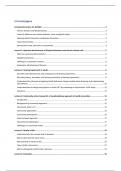College aantekeningen
Lectures Health Promotion and Disease Prevention 22/23
- Instelling
- Vrije Universiteit Amsterdam (VU)
Uitwerkingen hoorcolleges Health Promotion and Disease Prevention voor de master Health Sciences aan de Vrije Universiteit Amsterdam
[Meer zien]




